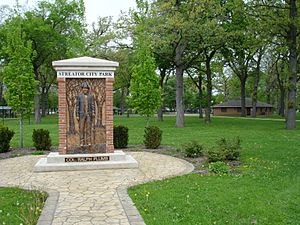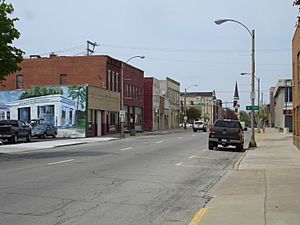Streator, Illinois facts for kids
Quick facts for kids
Streator
|
||
|---|---|---|
| Streator, Illinois | ||
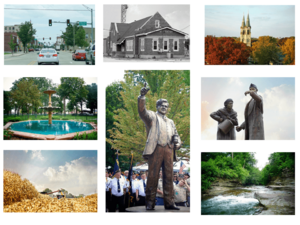
Images representing the city of Streator, Illinois
|
||
|
||
| Etymology: Named for Worthy S. Streator | ||
| Motto(s):
Quiet Surprise on the Prairie
|
||
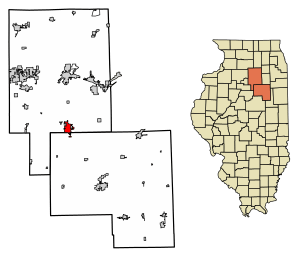
Location of Streator in LaSalle County, Illinois.
|
||
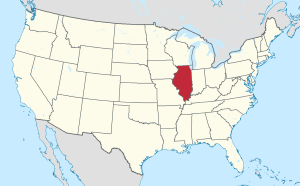
Location of Illinois in the United States
|
||
| Country | United States | |
| State | Illinois | |
| Counties | LaSalle, Livingston | |
| Townships | Bruce, Eagle, Otter Creek, Reading | |
| Settlement | 1861 | |
| Incorporated (city) | 1868 | |
| Government | ||
| • Type | Council-manager government | |
| Area | ||
| • Total | 7.38 sq mi (19.10 km2) | |
| • Land | 7.31 sq mi (18.93 km2) | |
| • Water | 0.07 sq mi (0.18 km2) | |
| Elevation | 623 ft (190 m) | |
| Population
(2020)
|
||
| • Total | 12,500 | |
| • Density | 1,694.69/sq mi (645.45/km2) | |
| Time zone | UTC−6 (CST) | |
| • Summer (DST) | UTC−5 (CDT) | |
| ZIP Code(s) |
61364
|
|
| Area code(s) | 815, 779 | |
| FIPS code | 17-73170 | |
| GNIS feature ID | 2395987 | |
| Wikimedia Commons | Streator, Illinois | |
| Website | www.ci.streator.il.us | |
Streator is a city in LaSalle and Livingston counties in the U.S. state of Illinois. It is located on the Vermilion River, about 81 miles (130 km) southwest of Chicago. This area is known for its flat prairie and farmland. In 2020, Streator had a population of 12,500 people.
History of Streator
People have lived in the area around Streator for a long time. In 1824, surveyors came to map the land for the Illinois and Michigan Canal. This canal would connect Chicago to the Illinois River, which flows into the Mississippi River. By the 1830s, families began to settle here.
In 1861, a miner named John O'Neill set up a trading post. He called it "Hardscrabble" because it was hard to climb the river banks with heavy loads. Another early name for the settlement was "Unionville."
Streator got its current name from Worthy S. Streator. He was a businessman from Ohio who helped fund the first coal mine in the area. Streator became a town in 1868 and a city in 1882. Col. Ralph Plumb was elected as its first mayor in 1882.
Streator grew quickly because of its coal mines, a large glass factory, and its location as a railroad center. Today, important businesses in Streator include Vactor (which makes heavy equipment), U.S. Foodservice (a food distributor), and Owens-Illinois (a glass bottle maker).
Streator is also known as the hometown of Clyde Tombaugh. In 1930, he discovered the dwarf planet Pluto. It's also where George "Honey Boy" Evans came from; he wrote the song "In the Good Old Summer Time."
The city hosts fun events every year, like Streator Park Fest, a Fourth of July celebration, the Roamer Cruise Night, and Light Up Streator. Streator is run by a city manager and a council. It has its own police and fire departments, and a public works system. The current mayor is Tara Bedei.
Early Settlements and Explorers
The Kaskaskia tribe, part of the Illiniwek group, were the first people to live in this region. Their main village was on the Illinois River near Utica, Illinois. The Kaskaskia were hunters, farmers, and traders.
French explorers Father Jacques Marquette and Louis Jolliet were the first Europeans to visit this area in 1673. In 1675, Marquette started a mission at the Kaskaskia village. Later, in 1679, another French explorer, Robert de LaSalle, ordered a fort to be built near what is now Starved Rock State Park.
Over time, this land became part of the United States. In the early 1800s, the city of Chicago began to grow, and the Illinois and Michigan Canal was built in 1821. This canal helped connect Lake Michigan to the Mississippi River, making it easier to ship goods. This led to more people buying land and new towns popping up quickly. John O'Neil started the first settlement in Streator in 1861 with his trading business.
Coal Mining and City Growth
Streator's story really began with coal. There are huge amounts of coal just below the ground in Illinois. In the mid-1800s, there was a big demand for coal.
In 1866, Worthy S. Streator, a railroad promoter from Cleveland, Ohio, helped start the first coal mining business here. He asked his nephew, Col. Ralph Plumb, to manage the mining. Plumb arrived in 1866. To make the project work, they needed a railroad line close to the mines.
Colonel Plumb also helped plan and set up the growing town. He was Streator's first mayor and served two terms. He helped build the city's first high school.
Streator grew very fast for several reasons:
- Chicago needed a lot of coal.
- Many immigrants from Europe wanted to come to America for new jobs.
- Business people from the East Coast invested money in the coal mines.
The Vermilion Coal Company told steamship offices about the new jobs and convinced railroads to share news about Streator. Land was sold cheaply to miners, but the company kept the rights to the minerals underground. In 1870, Streator had 1,486 people, but by 1880, its population had tripled!
Many immigrants came, first from Scotland, England, Wales, Germany, and Ireland. Later, many Slovaks, Czechs, Austrians, and Hungarians arrived. Today, many Streator residents are descendants of these early miners.
As the mining and glass-making industries grew, miners and workers earned more money. By 1884, about 20% of Streator's miners owned their own homes. Workers also formed groups like the United Mine Workers of America to improve their working conditions. Churches and social clubs also became popular.
A writer named H.F. Kett wrote in 1877 that Streator grew very quickly. He said it went from a small grocery store to a city of 6,000 people with churches, schools, businesses, and nice homes.
Besides coal, the area had rich clay and shale. This led to industries making bricks, tiles, and pipes. Eventually, these products became more important than coal. But Streator was most famous for making glass bottles. In the early 1900s, Streator was known as the "Glass Manufacturing Capital of the World."
However, as people started using more gas and oil, the demand for coal went down. Many of Streator's underground mines closed in the 1920s, and the last one shut down in 1958. Streator's population reached its highest point of about 17,000 in 1960 and has slowly decreased since then. Also, Streator is not very close to any major Interstate Highways, which has affected its growth.
Geography and Climate
Streator covers about 7.38 square miles (19.10 sq km). Most of this area is land, with a small part being water.
Land and Resources
Streator is located in a flat area of prairie land, near the Vermilion River. The land here was shaped by glaciers long ago.
Deep under the ground, there are huge amounts of coal. About 68% of Illinois has coal layers. It's estimated that there are 211 billion tons of coal under the surface in Illinois. However, this coal has a lot of sulfur, which can cause acid rain.
Streator's history with coal mining began in 1866 and lasted until the 1920s. The demand for Streator's high-sulfur coal decreased when lower-sulfur coal was found in Wyoming.
The area also has a special type of sand called St. Peter Sandstone. This sand is almost pure quartz, which is perfect for making glass. Streator has been mining this sand since the late 1800s for its glass factories.
Weather Patterns
| Weather chart for Streator | |||||||||||||||||||||||||||||||||||||||||||||||
|---|---|---|---|---|---|---|---|---|---|---|---|---|---|---|---|---|---|---|---|---|---|---|---|---|---|---|---|---|---|---|---|---|---|---|---|---|---|---|---|---|---|---|---|---|---|---|---|
| J | F | M | A | M | J | J | A | S | O | N | D | ||||||||||||||||||||||||||||||||||||
|
1.6
33
16
|
1.5
37
19
|
2.6
49
29
|
3.3
63
40
|
3.8
74
50
|
3.8
83
60
|
3.5
87
64
|
3.7
85
62
|
3.6
78
54
|
2.5
66
43
|
2.3
50
32
|
1.9
36
20
|
||||||||||||||||||||||||||||||||||||
| temperatures in °F precipitation totals in inches source: Illinois State Climatologist Data (Streator) |
|||||||||||||||||||||||||||||||||||||||||||||||
|
Metric conversion
|
|||||||||||||||||||||||||||||||||||||||||||||||
Streator has a continental climate, meaning it has warm summers and cold winters. The average winter temperature is about 25°F (-4°C), and the average summer temperature is about 75°F (24°C).
Streator gets about 34.68 inches (88.1 cm) of rain each year and about 22 inches (55.88 cm) of snow. The hottest temperature ever recorded in Streator was 112°F (44°C) in July 1936. The coldest was -25°F (-32°C) in January 1985.
| Climate data for Streator, Illinois (1991–2020 normals, extremes 1893–present) | |||||||||||||
|---|---|---|---|---|---|---|---|---|---|---|---|---|---|
| Month | Jan | Feb | Mar | Apr | May | Jun | Jul | Aug | Sep | Oct | Nov | Dec | Year |
| Record high °F (°C) | 69 (21) |
69 (21) |
87 (31) |
92 (33) |
99 (37) |
102 (39) |
108 (42) |
103 (39) |
103 (39) |
95 (35) |
81 (27) |
70 (21) |
108 (42) |
| Mean daily maximum °F (°C) | 31.9 (−0.1) |
36.7 (2.6) |
48.9 (9.4) |
62.2 (16.8) |
73.7 (23.2) |
84.1 (28.9) |
87.5 (30.8) |
84.2 (29.0) |
77.6 (25.3) |
64.7 (18.2) |
49.3 (9.6) |
37.2 (2.9) |
61.5 (16.4) |
| Daily mean °F (°C) | 23.9 (−4.5) |
28.0 (−2.2) |
39.1 (3.9) |
51.3 (10.7) |
62.7 (17.1) |
73.2 (22.9) |
76.5 (24.7) |
73.9 (23.3) |
66.4 (19.1) |
54.3 (12.4) |
40.8 (4.9) |
29.7 (−1.3) |
51.6 (10.9) |
| Mean daily minimum °F (°C) | 15.9 (−8.9) |
19.3 (−7.1) |
29.3 (−1.5) |
40.3 (4.6) |
51.6 (10.9) |
62.2 (16.8) |
65.5 (18.6) |
63.5 (17.5) |
55.2 (12.9) |
43.8 (6.6) |
32.2 (0.1) |
22.2 (−5.4) |
41.8 (5.4) |
| Record low °F (°C) | −20 (−29) |
−26 (−32) |
−10 (−23) |
8 (−13) |
23 (−5) |
37 (3) |
41 (5) |
39 (4) |
20 (−7) |
15 (−9) |
−9 (−23) |
−17 (−27) |
−26 (−32) |
| Average precipitation inches (mm) | 2.56 (65) |
1.92 (49) |
2.78 (71) |
3.73 (95) |
4.69 (119) |
4.67 (119) |
4.10 (104) |
3.70 (94) |
3.56 (90) |
2.98 (76) |
2.57 (65) |
2.17 (55) |
39.43 (1,002) |
| Average snowfall inches (cm) | 9.6 (24) |
4.8 (12) |
3.7 (9.4) |
0.7 (1.8) |
0.0 (0.0) |
0.0 (0.0) |
0.0 (0.0) |
0.0 (0.0) |
0.0 (0.0) |
0.0 (0.0) |
0.8 (2.0) |
6.8 (17) |
26.4 (67) |
| Average precipitation days (≥ 0.01 in) | 8.9 | 7.6 | 9.6 | 11.6 | 12.3 | 10.7 | 8.7 | 9.3 | 7.4 | 9.2 | 9.0 | 8.8 | 113.1 |
| Average snowy days (≥ 0.1 in) | 4.8 | 3.9 | 1.5 | 0.4 | 0.0 | 0.0 | 0.0 | 0.0 | 0.0 | 0.0 | 0.9 | 3.6 | 15.1 |
| Source: NOAA | |||||||||||||
Past Weather Events
On July 17, 1903, a strong tornado (F3) hit the west side of Streator. It sadly killed six people and injured 30 others. Five people died when a grandstand at a racetrack collapsed during the storm.
The worst flood in Streator's history happened in 1951. The Vermilion River rose to a flood level of 18 feet (5.5 meters).
Another tornado (EF2) swept through southern Streator on June 5, 2010. It caused a lot of damage to homes, but thankfully, no one was killed.
Population and People
| Historical population | |||
|---|---|---|---|
| Census | Pop. | %± | |
| 1870 | 1,486 | — | |
| 1880 | 5,157 | 247.0% | |
| 1890 | 11,414 | 121.3% | |
| 1900 | 14,079 | 23.3% | |
| 1910 | 14,253 | 1.2% | |
| 1920 | 14,779 | 3.7% | |
| 1930 | 14,728 | −0.3% | |
| 1940 | 14,930 | 1.4% | |
| 1950 | 16,469 | 10.3% | |
| 1960 | 16,868 | 2.4% | |
| 1970 | 15,600 | −7.5% | |
| 1980 | 14,795 | −5.2% | |
| 1990 | 14,121 | −4.6% | |
| 2000 | 14,190 | 0.5% | |
| 2010 | 13,710 | −3.4% | |
| 2020 | 12,500 | −8.8% | |
| U.S. Decennial Census | |||
In 2020, Streator had 12,500 residents. There were 5,762 households, and 2,949 families living in the city. The city's population density was about 1,695 people per square mile (645 per sq km).
Most of the people in Streator (about 81%) are White. About 3.5% are African American, and about 13.6% are of Hispanic or Latino background.
About 20% of the population is under 18 years old. The average age in Streator is 40.4 years. The median income for a household was $40,778, and for a family it was $59,266. About 21.5% of the population lives below the poverty line.
Streator is a main city in the Ottawa, IL Micropolitan Statistical Area. This means it's an important center for a smaller group of towns and communities.
Economy and Jobs
Streator's economy has always been connected to its natural resources. Coal was the first big industry from 1866 until the late 1920s. As the city grew, the silica (sand) deposits became important for Streator's next big industry: making glass containers.
Even though the coal industry ended, glass manufacturing is still important in Streator. Farming and related businesses in the nearby farmlands also play a big role in Streator's economy. While manufacturing provides a lot of income, the service industry now offers the most jobs.
Glass Manufacturing History
Making glass, especially glass blowing, used to be a very skilled job. Many glassblowers in America came from Europe or learned their skills there. Many of Streator's immigrant coal miners also learned how to blow glass.
Streator had everything needed for glassmaking: lots of high-quality silica (the main ingredient), coal to heat the furnaces, and skilled workers. This led to Streator's second major industry, which started in 1887 with the Streator Bottle and Glass Company. Other companies like Thatcher Glass Manufacturing Corp and Owens-Illinois soon followed. Throughout the 1900s, Streator was known as the "Glass Container Capital of the World."
Main Employers Today
Three of Streator's largest companies have been around for a long time.
- Vactor Manufacturing started in 1911. They used to make milking machines. In the 1960s, they invented a special vehicle for cleaning sewers. Today, they are a world leader in making heavy-duty sewer cleaning equipment. They are the second-largest employer in Streator with 530 employees.
- Owens-Illinois opened its Streator plant in 1916. They make special lightweight, strong beer bottles. In the 1960s, they had 3,500 employees. Today, they are Streator's fifth-largest employer with 210 employees.
- St. Mary's Hospital is the city's largest employer with 550 employees. It was founded in 1886 and serves Streator and the surrounding areas. In 2015, OSF Healthcare system bought the hospital.
Streator also produces building bricks, milk and soda bottles, auto parts, sewer pipes, and clothing. Its main farm crops are corn and soybeans.
Arts, Culture, and Events
Streator's parks and events show off its history and prairie location. Many people from Streator have also become famous in the arts.
Arts and Entertainment
The Community Players of Streator put on live theater shows each year at the William C. Schiffbauer Center for the Performing Arts at Engle Lane Theatre.
The Majestic Theatre, a movie house with an art deco style, first opened in 1907 as a vaudeville theater. It has opened and closed many times over the years. It used to show new movies and host live music, but it has since closed due to damage.
In 2018, a group called The Walldogs painted 17 murals in Streator. Now, downtown Streator has more than 20 beautiful murals.
Museums and Historic Places
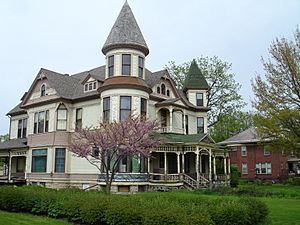
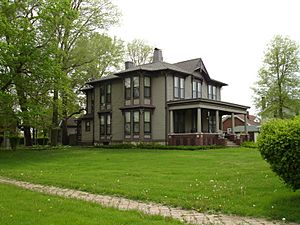
The Streatorland Historical Society Museum has exhibits about Streator's history and items from famous people who lived there. One special exhibit is about the Free Canteen. This was a group of local volunteers who served over 1.5 million soldiers during World War II. The soldiers would briefly stop at the city's old Santa Fe Train Depot while traveling by troop trains. The museum also has a homemade telescope used by astronomer Clyde Tombaugh and a Burlington Northern caboose (a type of train car).
During World War II, the Streator Santa Fe Train Depot was a very busy place. Millions of soldiers and sailors passed through the town on their way to or from war training. Starting in 1943, the Streator Parents Service Club, a group of parents of veterans, created the Streator Free Canteen. Volunteers gave out sandwiches and coffee and offered a friendly welcome to the service members. Over 1.5 million service members were hosted during the 2.5 years the canteen operated. On Veterans Day in 2006, a bronze statue was dedicated at the Santa Fe Railroad Station to honor the "Coffee Pot Ladies" of Streator.
The Streator Public Library was built with a $35,000 grant from Andrew Carnegie. When it opened in 1903, some people thought it was too fancy with its domed ceiling and columns. The Library was added to the National Register of Historic Places in 1996.
Other notable buildings include the Ruffin Drew Fletcher House and the Silas Williams House, both listed on the National Register of Historic Places. St. Stephens Catholic Church, founded in 1883, was the first Slovak Catholic church in the United States.
Annual Events
- Streator Food Truck Festival is held every May.
- Park Fest takes place during Memorial Day weekend in City Park. It includes a carnival, a 5K run, and a talent contest.
- A Memorial Day observance is held at Veterans Plaza in City Park.
- The annual Fourth of July celebration lasts for over four days with events throughout the city. There's a parade downtown and fireworks at Streator High School.
- Roamer Cruise Night is a car show held on Labor Day weekend in downtown Streator. It attracts over 600 cars and 18,000 visitors.
- A Veterans Day observance is held at Veterans Plaza.
- Light Up Streator is an event held the first Saturday after Thanksgiving. Volunteers decorate the city, especially City Park, with holiday lights.
- The Keeping Christmas Close to Home Parade of Lights is held the weekend after Thanksgiving.
Media Outlets
Streator has one daily newspaper, The Times. It provides local news for the area. Streator also has three local radio stations: WSPL 1250 AM (news/talk), WSTQ 97.7 FM (contemporary pop), and WYYS 106.1 FM (classic hits).
Parks and Recreation
Streator has eight local parks and one public golf course.
- Spring Lake Park is a 37.2-acre (15.1 ha) park west of the city. It has creeks, waterfalls, and six trails for hiking, horseback riding, and picnicking.
- City Park is the main park in downtown Streator. It has Veterans Plaza, which honors citizens who died in wars. It also has the Reuben G. Soderstrom Plaza, a monument to a famous labor leader from Streator. City Park hosts many annual events like Park Fest and Roamer Cruise Night.
- Marilla Park is a larger park in northeast Streator with picnic areas and a playground. A Disc Golf Course was added in 2012.
- Other city parks include Oakland Park, Central Park, Bodznick Park, Merriner Park, and Southside Athletic Park.
Sports and Activities
Streator offers many organized sports for kids, including youth football, soccer (American Youth Soccer Organization), and Little League Baseball. The Streator High School "Bulldogs" and Woodland High School "Warriors" compete in different conferences. Local golf can be played at Anderson Field Municipal Golf Course and The Eastwood Golf Course.
The Streator Zips won the Illinois State Championship for Mickey Mantle baseball in 2003 and 2004. In 2008, the Streator Reds (age 16-and-under) won the Senior League Illinois State Tournament. The Streator 10-year-old All-Stars won the city's first Little League State Baseball Championship in 2002.
Several local residents have become professional athletes:
- Doug Dieken played 14 seasons for the Cleveland Browns in the National Football League.
- Bob Tattersall was a famous Midget Car Racing driver in the 1950s and 1960s.
- Clay Zavada played as a relief pitcher for the Arizona Diamondbacks.
- Other local baseball players who played in Major League Baseball include Andy Bednar, Rube Novotney, and Adam Shabala.
Outdoor Adventures
Outdoor activities in the Streator area mostly involve the Vermilion River, Spring Lake Park, and nearby state parks. People enjoy fishing, kayaking, and canoeing on the Vermilion River. Matthiessen State Park and Starved Rock State Park are close by and offer hiking, hunting, and camping in their unique natural areas.
Education in Streator
Streator has several school districts.
- Streator Elementary School District serves Centennial Elementary School, Kimes Elementary School, and Northlawn Junior High School.
- Streator Township High School District serves Streator Township High School.
- Woodland Community Unit School District #5 serves the Livingston County part of Streator, with Woodland High School and a combined elementary/junior high school.
- Streator also has one private elementary school, St. Anthony's Catholic School (now St. Michael the Archangel).
- Nearby, Illinois Valley Community College is located in Oglesby, Illinois.
- The Carnegie Foundation helped fund the Streator Public Library, which opened in 1903 and was added to the National Register of Historic Places in 1996.
Getting Around Streator
Streator is served by Illinois State Routes 23 and 18, which meet downtown. It is about a 15-minute drive from the nearest major interstate highway. Train services are provided by Norfolk Southern Railway, BNSF Railway, and the Illinois Railway. Streator does not have its own public transportation system.
Famous People from Streator
- Burt Baskin, who helped start the Baskin-Robbins ice cream chain.
- Kevin Chalfant, lead singer of The Storm.
- Mary Lee Robb Cline, actress.
- Phillipe Cunningham, Minneapolis City Council Member.
- Doug Dieken, NFL player for the Cleveland Browns.
- Doriot Anthony Dwyer, flutist, first woman to be a Principal Chair in a major US Orchestra.
- George "Honey Boy" Evans, songwriter.
- Edward Hugh Hebern, inventor of encryption machines.
- William Jungers, professor.
- Patrick Lucey, former Illinois Attorney General and Mayor of Streator.
- Clarence E. Mulford, author of Hopalong Cassidy.
- Ed Plumb, musical director for Disney's Fantasia and composer for Bambi.
- Ralph Plumb, Streator's first mayor and a U.S. Representative.
- Ken Sears, catcher for the New York Yankees and St. Louis Browns.
- Adam Shabala, outfielder for the San Francisco Giants.
- Reuben G. Soderstrom, President of the Illinois State Federation of Labor.
- Clyde Tombaugh, astronomer who discovered Pluto.
- Charles Turzak, artist.
- Clay Zavada, pitcher for the Arizona Diamondbacks.
Images for kids
See also
 In Spanish: Streator (Illinois) para niños
In Spanish: Streator (Illinois) para niños



